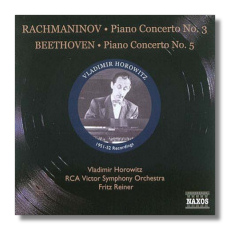
The Internet's Premier Classical Music Source
Related Links
- Latest Reviews
- More Reviews
-
By Composer
-
Collections
DVD & Blu-ray
Books
Concert Reviews
Articles/Interviews
Software
Audio
Search Amazon
Recommended Links
Site News
 CD Review
CD Review
Vladimir Horowitz

1951-52 Recordings
- Sergei Rachmaninoff: Piano Concerto #3 in D minor, Op. 30
- Ludwig van Beethoven: Piano Concerto #5 "Emperor" in E Flat Major, Op. 73
Vladimir Horowitz, piano
RCA Victor Symphony Orchestra/Fritz Reiner
Naxos 8.110787
Despite the classic status of this Rachmaninoff performance, and the relative neglect of the Beethoven, I have to say I enjoyed the Beethoven more. In both recordings Horowitz is keenly partnered by the great Hungarian conductor Fritz Reiner, shortly before his tenure with the Chicago Symphony Orchestra. These were some of Horowitz's last concerto recordings before his nervous collapse in 1953 and subsequent temporary retirement.
Listening to the highly-strung performance of Rachmaninoff's Third Concerto one wonders if the signs are already there. This is the work most associated with Horowitz, one which he made his own, much to the bewilderment of Rachmaninoff. By 1951 it had been in his repertoire for over twenty years, and comparison with the first commercial recording (conducted by Albert Coates) and a live performance with Barbirolli (on APR) reveals how much his conception of the work had changed.
The relatively straight-laced early version with Coates had given way to an outsize personality on display with Reiner, less Rachmaninoff perhaps and more Horowitz. The virtuosity is truly impressive, and so is the way that every corner of the work is explored, with not a note passing without Horowitz's indelible stamp. And the stamp is dark and diabolical at times. The sense of chaos he conveys at 8'36" in the first movement is remarkable. Also the limitless energy and drive he gives each phrase which propels the music along like a jet engine. In fact the performance is sometimes something far greater than that of a pianist playing a composer's work. The Concerto was by now so internalised in Horowitz's psyche that the distinction between work, performer and performance is blurred. It is a work of art.
The problem lies not in the extraordinary moments, but in the way these moments don't always manage to cohere. He doesn't seem to have a structural grasp of the work, so that it ends up sounding fragmented. Tempos fluctuate wildly; phrases are cut or broken perversely, so that Horowitz makes the music at times harder to understand than it is. Take for example 3'46" into the 1st movement, where he distorts the right-hand melody by sharply slowing down and diminuendoing in the middle of the phrase. Or try 1'36", an example of how Horowitz fails to blend into the orchestral part or the musical whole.
Over-projection also at times mars the overall conception, for instance at 6'55" (1st movement), where the left-hand melodic entry is surely exaggerated. It doesn't help that the recording favours the piano, nor that the piano tone is hard and thin.
The performance of the Emperor from a year later is remarkably different. This account contains heroism and poetry in equal measure, and Horowitz's playing is supremely judged, direct and beautiful, without any of the affectation which sometimes tarnished his performances. Here he lets the music speak for itself, lending a classical poise to the proceedings. Horowitz is alive to every nuance of character. Some may find his tempi wayward at times, or his clanging pedalled bass notes vulgar (1st movement octaves at 18'52", 3rd movement at 2'00"), but who could not warm to his ravishing entry in the slow movement, full of beauty and calm, or the way he inhabits fantasy, exhilaration and pure rhythmic drive all within half a minute in the final movement (4'10" to 4'45").
Reiner secures some beautiful playing from the RCA Victor Symphony Orchestra – just listen to the solos from 9'09" in the first movement. He also creates wonderfully clear textures so that everything can be heard, and the sound quality here is better than in the Rachmaninoff, with an excellent balance between soloist and orchestra, though there is still something of the harsh piano tone common to many RCA Horowitz recordings of the 1940's and 1950's. The accompanying notes are excellent too.
Copyright © 2006, Alex Demetriou


















